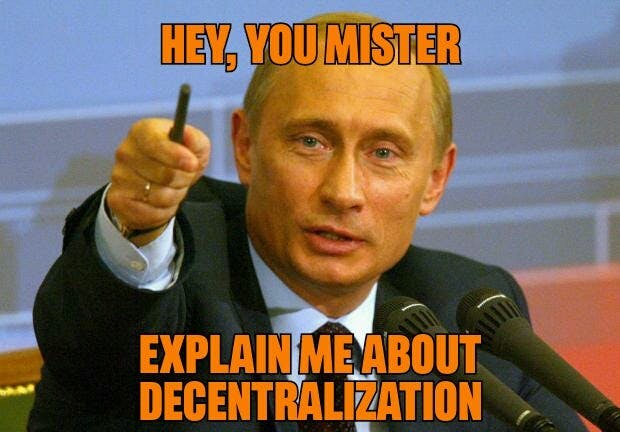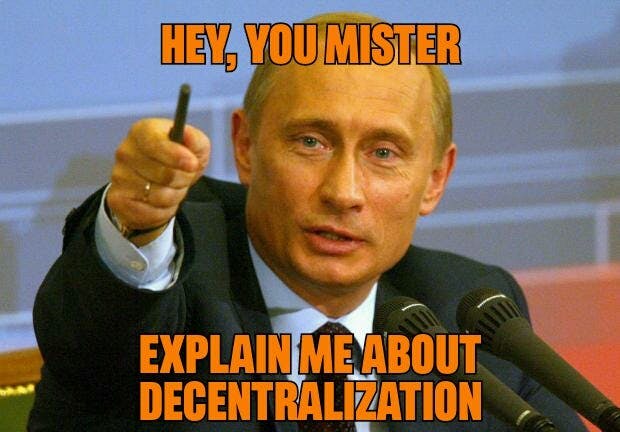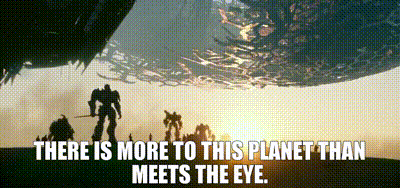
Disambiguating Decentralization
The untold truth about how things actually work
Tl;dr
Decentralization is a process not an event.
True decentralization exists on multiple levels.
Decentralization is something that is applicable & useful only at scale.
Not everything needs to be decentralized.
Crypto is a great tool to achieve decentralization.

The most used & abused buzzword of the entire crypto industry has been decentralization.
Many people assume that by default if a project is in the crypto space then it is/must be decentralized.
As history would show us, that is absurd & untrue.
Moreover, it does not have to be.
Everything under the sun starts off centralized. (Yes, even bitcoin started with one node).
Decentralization is a complex subject.
While it does represent the noble mission of displacing rent-seeking middlemen & nosey governments, its actual meaning has gotten lost in all the chaos of ICO’s, memecoins, gigachads & NFTs.
Intuitively, most people understand the premise of decentralization, the diffusion of power from a single source to many. However, what is commonly overlooked is that decentralization is a subjective spectrum, not a definitive end.
If a network has 1,000 nodes is it decentralized?
If a company has 300 owners/shareholders is it decentralized?
If a government has 3 cabinets is it decentralized?
Somebody will say yes.
Some will say no.
Majority will say they don’t know.
The truth here is that everyone is right!
Decentralization is a matter of perspective & design.
If a network started with 10 nodes and over the course of a year scaled to 1,000 nodes, then relative to its humble beginnings, it becomes much more decentralized. However, if we ask people that are involved in a network with 15,000 nodes they might say that they don’t agree.
Of course, things get more complicated when we factor in the separation of roles for nodes, where the 10 original nodes retain 50% control & 990 new nodes have the other 50%; then obviously this is not a decentralized network.
Now let’s say that the network has a system whereby over the course of the next few years, the original nodes spread out their control throughout all new nodes; then it's a decentralizing network.
This is a matter that is best explained by the example of DEFI.
Whenever a project is getting started, it should be centralized. Typically, projects will provide a roadmap or in some way address the topic of decentralization. If they do not, then by default they intend on being centralized… And there is nothing wrong with that!
So many individual projects get unfair hatred because they have a small group of owners.
What people miss here is the bigger picture!
Decentralizing a project too early will result in failure. A “faithful” community of people will not have the same vision or technical capabilities that a founder & their team would.
Think about it, who would you rather have build a lending protocol, a team of 10 expert engineers or a group of 2500 scrambled Twitter tweeters? Where would you feel more comfortable putting your money?
Here is the caveat that goes over many people’s heads.
Sure, if a protocol has 5 owners, it is centralized…
HOWEVER!
If there are 5,000 protocols with 5 owners each, guess what… the projects may not be decentralized, but the industry is!

Decentralization, just like anything else in life, comes with its own set of tradeoffs. In return for having more owners, things get more disorganized, inconsistent & chaotic.
The biggest problem of decentralization is coordination.
Trying to coordinate 5 people is easily doable. Trying to coordinate 15,000 people becomes insanely complex. The amount of communication needed is mind-boggling, there will be people that are unavailable, people that miss the message, or those that just forget. Then those that show up are upset they are forced to be doing all the work, but wait, those that forget to show up get mad that a decision was made without them. This is a never-ending cycle of inefficiency.
Three Phases of Decentralization in Crypto Projects
Centralized.
The starting point of any idea. Here is where all of the most difficult planning, technical & ideological development takes place. It is very easy to identify if a project is centralized based on the activity that is taking place. If it is fundraising, it is centralized. If the code is only partially open, it is centralized. If the top 100 addresses own >90% of the tokens, it is centralized.
Decentralizing.
This is when a project starts to hand over control from the founding team to its community. Code slowly becomes open source, token balances are more distributed (hello airdrops), & a DAO is established. Typically this is a prolonged process that requires a lot of activity on behalf of interested users. This is not as simple as an airdrop. This requires time, evaluation & proofs of commitment. In spite of everything seeming right, bad actors will always show up & try to take over the network or squeeze out all the profit from the hard-earning community members.
Decentralized.
Full decentralization exists only when every element of the project is out of the hands of the original team/founders & the government cannot blame any single party for what happens. We have actually not had a chance to experience this with anything except Bitcoin thus far & have much to learn about how real decentralization will actually materialize itself.
Where to find decentralization in Crypto?
There are 4 general touchpoints that dictate true decentralization:
1) the network (consensus mechanism + node count)
2) the governance model (DAO voting or CPU/machine node-based?)
3) the code (is it private or open source)
4) the tokens (allocation/balance held by accounts)
Just because there are 10,000 nodes on a network, it does not mean the project is decentralized. Here the important factor of a consensus mechanism comes into play. In a Proof-of-work model, where anybody can join or leave at will, 10,000 nodes can be considered decentralized. On the other hand, if it is a delegated proof of stake model, then the node count won’t really matter, because ultimately only a small group of delegates will control the network anyway.
Governance is another slippery subject. While DAO’s are supposed to represent the be-all-end-all structure of organizations, on-chain activity is easy to fake. DAO voting is a mechanism based on token holders, where usually, a 1-to-1 system (one token equals one vote) is implemented. Single entities with huge holdings (whales) can spoof accounts & split up their tokens across a bunch of smaller wallets; ultimately tilting all decisions in their favor. A prominent example of this happened with UniSwap’s UNI token. They leverage a sly weighted delegation that prioritizes the wealthy.
Moreover, it has become public knowledge that the prominent VC firm a16z owns a huge portion of the tokens & yes, they split them up across multiple wallets.
Things quickly get even more complicated with the introduction of specialized machines. Bitcoin’s POW started off as a simple 1CPU-1Vote system. This system is still in place. However, savvy technologists have found other loopholes by which to break this system & take over control. Hello ASIC (Application-Specific-Integrated-Circuit) miners. While previously it was possible to mine with a simple laptop, now in order to join the network people must acquire expensive machinery. Moreover, they must acquire A LOT of these machines. This is not to say things are good or bad; stronger machines means more robust network security; it just also means that it becomes more difficult for average people to join the network.
As it pertains to the code, it is not as straightforward as it may seem. Yes, it is binary in the sense of whether code is open-sourced or not. Surely, it is important to understand that not just a portion of the code, but all of it must be put into the public domain… But, there is the greater nuance of the ability to push updates. Small groups of developers become gatekeepers to the code. This is important because they serve the important function of protecting the protocols from malicious actors; however, they also cause a bottleneck for testing & innovation. Not bad, just fact.
Tokens are a concept that has existed in computer science & distributed systems LONG before the arrival of crypto. In crypto, they are the units of account in a ledger that represent ownership of something. We’ve already spoken that tokens are used for the allocation of voting in DAO functions; but in the economic sense, basic distribution of token balance among wallets is (for now) the best & only way to gauge decentralization. Still, as with the DAO voting, this is almost always spoofed. Not necessarily by whales as an attempt to fake out the community, but as a means to protect themselves in the event of losing wallet access or robbery.
First somebody has an idea. They share this idea with other people. Then those people tell even more people. As network effect would have it, by the time the 1,000,000th person hears the idea, nobody owns it. It belongs to the ethers of society (no pun intended).
I am very pro decentralization, after all, this is how we circumvent shadowy government operations. At the same time, I strongly support the development of new project that are centralized; that is where the innovation happens.
Stay sharp friends
&
Always remember
“Nothing is either good or bad, but our thinking makes it so” — William Shakespeare


